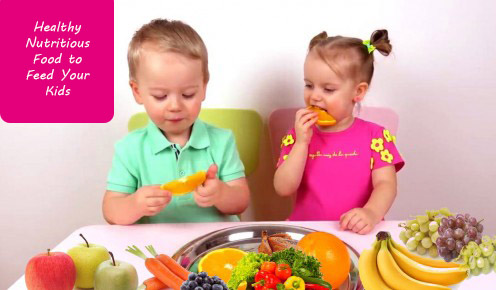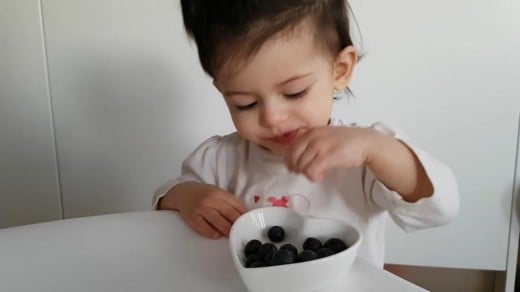Healthy Nutritious Food to Feed Your Kids
Healthy Nutritious Food to Feed Your Kids
There are many factors that influence a child’s growth and development; one of it being in terms of nutrition. It may not seem like a big deal, but it certainly does have a huge impact on your child in the long run.
Mealtimes at home should be an enjoyable affair that your kids look forward to. Apart from feeding your kids delicious food, it is important to make sure the food contains necessary nutrients that will nourish their little bodies to facilitate proper growth and development.

A healthy nutritious diet has a profound effect on a child’s sense of mental and emotional well-being. It helps to prevent conditions such as;
- Depression
- Anxiety
- Bipolar disorder
- Schizophrenia
- Attention Deficit Hyperactivity Disorder (ADHD)
- And lowering the risk of suicide in young people
If your child has already been diagnosed with a mental health problem, a healthy diet can help your child to manage the symptoms and regain control of their health.
It is better to start instilling good eating habits in your child at an early age instead of trying to curb bad eating patterns when your child gets older. Here are some of the foods that you can integrate into your child’s daily diet to keep them happy and healthy.
Blueberries

Blueberries are packed with;
- Antioxidants
- Vitamin C
- Potassium
- And a host of other amazing nutrients
Which no wonder makes it a superfood. The fruit contains properties that can help prevent urinary tract infections (UTI), which aids in potty training your child. You may start including blueberries into your child's diet when they reach between six to nine months old.
However, do be on a lookout for any symptoms of allergic reactions, although it is rare in the case of blueberry consumption after the recommended age. There are multiple ways you can introduce blueberries to your toddler; be it in fresh, frozen, dried, freeze-dried and liquefied forms.
You can make your own baby food at home using blueberry as an ingredient. The recipes are quite simple and straightforward. For older children, blueberries are a good option as a wonderful addition to fruit salads, breakfast pancakes, jams, waffles, and a refreshing smoothie. You can even up it a notch by freezing leftover smoothie into popsicles for a cooling snack.
Milk

Milk is certainly the most important food in the first few years of your child's life. It is a great source of;
- Calcium
- Vitamin D
- Protein
Your child needs calcium to develop strong and healthy bones and teeth. Surprisingly, calcium is also found to help prevent headaches and in certain cases, migraine.
The vitamin D in milk helps your child to absorb calcium better, reduce inflammation and even boost their immune system. The best type of milk would definitely be breast milk but if you choose to wean your child, it is highly recommended to wait until they are at least one year of age.
This is because babies younger than one will have a hard time digesting dairy products. Whole milk would be an ideal option for kids between one and two years of age due to its fat content, which helps support nerve and brain development.
Beyond that age, you may switch to fat-reduced varieties to moderate their intake of fat and cholesterol. There are countless varieties available in the market that cater to the different age groups. One relatively good place that offers a wide variety of dairy products to many states would be Plains Dairy in Amarillo, Texas.
Peanut butter

According to the American Academy of Pediatrics, peanut butter is a versatile treat that can satisfy even the pickiest eater. However, some pediatricians do advise parents to wait until the child is beyond two years old to start including it in their diet.
Peanut butter is a good source of;
- Protein
- B vitamins
- Iron
- Folic acid
- Fiber
Additionally, peanut butter is also high in monounsaturated fats, which are good for the heart and the good fats present in it helps your child's body absorb fat-soluble vitamins.
Peanut butter is a delicious treat on its own but you can up the game and make it much more enjoyable for your kids. You may mix peanut butter with yogurt and serve it on a spoon.
Another cool and delicious way to feed your child peanut butter is by making a peanut butter banana smoothie, which would be a great treat in the summer. If you fancy baking, you may want to add peanut butter into your baked goods like muffin, cupcakes, or even into breakfast pancakes.
Fish

Fish is an ideal food source for growing kids as it is rich in;
- Protein
- High in biological value
- The Omega-3 fatty acid, Docosahexaenoic acid (DHA), and vitamin A in fish are essential for growth and development of brain tissues, nourishes the retina, and helps in maintaining good eyesight
- Feeding your kids fish on a regular basis - three times a week also helps reduce the risk of various types of cancer
- The Omega-3 fatty acids and selenium, which are abundant in fish, creates a protective enzyme coating in the body to protect and repel from cancer
There are a few safety measures to observe when introducing fish to your child especially if they have just started on solids. To ensure that the fish you use in your cooking is thoroughly cleaned with its bones removed completely.
You should never feed your child fish in its raw form. The choice of fish you use is equally important; it has to be fresh and be sure to avoid varieties that are high in mercury content like mackerel.
For babies that just started on solids you may prepare a simple fish puree and to make it more nutritious, throw in some carrots in the mix. For older kids, you can serve them breaded salmons strips, which makes a really good finger food.
Chicken

Chicken is a great source of;
- First-class protein
- Facilitates growth and development
- Helps children to grow taller and stronger
Due to its high protein content and low calories, chicken meat is known as an effective option in weight management and may help children who are obese to regulate their weight.
Consuming lean parts of chicken meat is also known to be good for the heart. Ideally, your child can start having his first taste of chicken meat once they turn six months old and have started on solid foods.
However, the introduction of chicken meat into your child's diet should be done gradually. You may want to withhold chicken meat from your child's diet if they have a sensitive digestive system and weak immune system as it will increase their risk of developing allergic reactions.
If your child shows signs that they are able to consume chicken meat well, you can have a diversified menu of purees and stews combined with other ingredients like sweet potatoes and other types of vegetables.
Cheese

Cheese, like milk, is a great source of calcium. The calcium in cheese is essential for building strong bones and teeth. Regular consumption of cheese may help prevent tooth cavities and bone problems such as osteoporosis, due to the calcium in it.
Cheese also contains loads of dietary protein that helps build strong muscles, bones, and other vital organs making it the perfect dietary supplement for your growing child.
Universally, cheese is one of the most loved foods and introducing it to your child will be an exciting occasion. For babies, you can start to offer them cheese once they can start chewing, which usually starts around six to nine months old.
For children that just started on solid foods, there is a number of ways you can include cheese in their meal preparation. Some simple and delicious menu can be achieved by simply adding cheese into an omelette, rice, and pasta.
Cheese and dishes laden with it may be high in calories and fat. Hence, choose lower-fat versions of cheese for children over the age of two, since they do not need the extra fat in their diet. Good things are best enjoyed in moderation, and this principle applies when it comes to enjoying cheese as well.
Carrots

Carrots are rich in fiber, which helps to regulate bowel movements. Carrots are also a great source of beta-carotene; when consumed it will be converted by the body into Vitamin A (retinol), which is good for the eyes.
Carrots also promote a strong immune system and contain photochemical that protects against heart disease and certain cancers. It is best to wait until your baby is at least six months old before you introduce carrots into their diet.
However, be sure to use real authentic carrots and not the 'baby cut' variety that is usually advertised as 'baby carrots'. The 'baby carrots' are actually carrots that are cut from full-sized old carrot and bleached in chlorine to prevent them from turning white while in the package.
It is better to prepare and slice the carrot on your own and use them to make delicious and healthy purees. There are a wide variety of purees that can be made using a carrot as an ingredient. You may even add other vegetables like parsnip, potato, peas and even chicken for a yummy meal.
Broccoli

Broccoli is a nutritious vegetable that is loaded with nutrients and vitamins such as;
- Potassium - to help heart and muscles work better
- Vitamin A - to develop strong eyesight
- Vitamin C - to boost the immune system and keep infections at bay
Broccoli is also a great source of soluble fiber and makes a good addition to baby food. Soluble fiber helps loosen bowels and aids healthy bowel movements. Although you may be excited to feed your baby his first broccoli, it is best to wait until he is between eight to ten months old.
Broccoli is a fiber-rich vegetable that can be rough on a young infant’s digestive system and lead to gas. Once your child is able to consume broccoli without complications, you may try out some delicious recipes like the basic broccoli puree, broccoli casserole, and even broccoli soup. You may also integrate other items in your purees; broccoli is an ideal mix with other veggies, grains, and protein.
Eggs

Eggs have numerous nutritional benefits and are a great source of;
- Iron
- Protein
- Fats
- Vitamins A, D, E
- B12
- Choline
The protein in eggs aid in new cell regeneration and help kids grow bigger and stronger. Choline, an organic water-soluble compound that helps build membranes of cell and is important for brain development is critical for developing children.
In its simple form, eggs actually carry a range of health benefits that are good for kids. According to a latest infant feeding guideline from Health Canada, it is recommended to introduce whole eggs to your child as soon as they reach six months of age, or as soon as your child starts eating whole foods.
You may first introduce egg to your child either as an omelette or scrambled to make it easy for them to eat. As they progress in age and is able to chew properly, you may feed them much more complex recipes like egg burrito and egg pizza, for instance.







